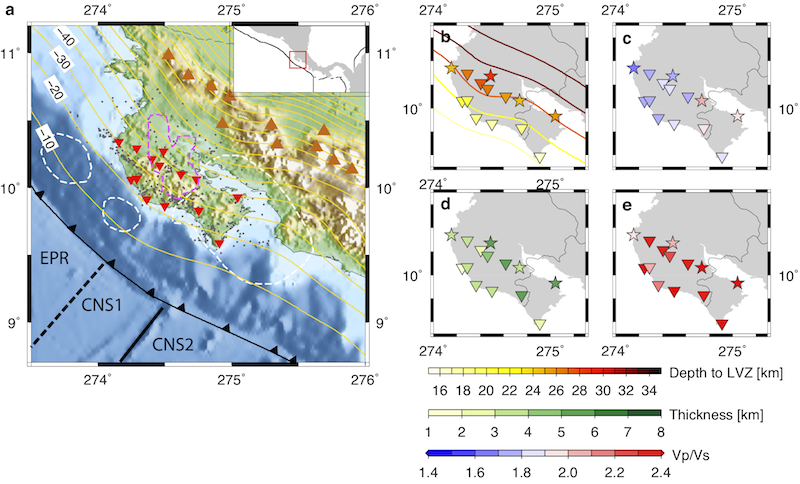2012 IRIS Workshop
Structural and Hydrologic Controls on Subduction Zone Seismogenic Behaviour at the Nicoya Peninsula, Costa Rica
Pascal Audet: University of Ottawa, Susan Y Schwartz: University of California Santa Cruz
(a) Map of the Nicoya Peninsula, Costa Rica, with seismic station distribution (inverted red triangles), slab contours (yellow lines), seismicity (grey dots); inferred slow slip for the 2007 event (white contours) and epicentral locations of non-volcanic tremors (magenta contour). Segmentation of incoming Cocos plate: EPR, East Pacific Rise; CNS, Cocos-Nazca Spreading. (b-e) Inversion results: (b) depth to top of the slab; (c) Vp/Vs of overriding forearc; (d) thickness of low-velocity zone (LVZ) interpreted as upper crust of subducting plate; and (e) Vp/Vs of the LVZ.

Full-resolution graphics file in original format: 0058.tiff
Subduction zone thrust faults exhibit variations in rupture behavior that include potentially great (M>8) earthquakes and slow propagating (M~6) slip. Factors controlling transitions in frictional properties are poorly constrained and include variations in temperatures, lithologies and pore-fluid pressures. Recent seismic studies have established a correlation between the locations of tremors in slow earthquake source regions with a zone of inferred high pore-fluid pressures within the subducting oceanic crust. If fluid processes control slow earthquakes and tremors, variability in spatial and temporal occurrences of slow earthquakes may be related to hydrologic properties of structural elements within the subduction zone. Along the Nicoya Peninsula, Costa Rica, the seismogenic zone is characterized by strong heterogeneity in mechanical properties. Slow slip accompanied by tremor occurs over a wide range of depths, updip, along strike and downdip of locked patches. In addition, a lateral contrast in fault stability from a locked portion in the northwest to a partially locked segment in the southeast appears to correlate with the thermal state of the incoming Cocos plate (Figure 1a). We use receiver functions to examine subduction zone structure at the Nicoya Peninsula and report two major findings (Figure 1b-e). First, we report evidence for inferred high pore fluid pressures within the subducting oceanic crust, in agreement with results globally. Second, we find a lateral contrast from normal to low seismic shear velocities within the overriding forearc from northwest to southeast that correlates with a change in interseismic locking, seismogenic behavior and thermal structure of the incoming plate. We interpret these results to represent differences in upper plate strength caused by thermally induced variations in hydraulic conductivity of the subduction zone thrust fault. In particular, large hydraulic conductivities in the southeast allow fluids to permeate the
Keywords: receiver_functions, subduction_zone, seismogenic_behaviour
